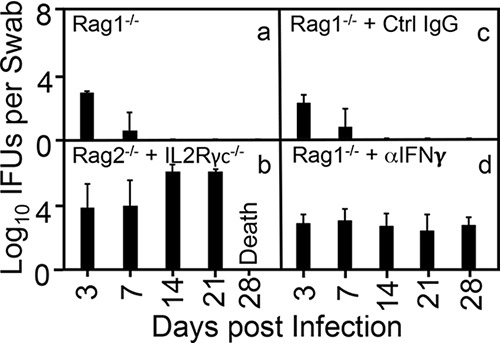FIG 3.

Deficiency in innate but not adaptive immunity is required for rescuing the colonization of the intracellular bacterial mutant. Mice deficient in recombination-activating gene 1 (Rag1−/− [a]), Rag2 plus interleukin 2 (IL-2) receptor common gamma chain (Rag2−/− + IL-2γc−/− [b]), mice deficient in Rag1 and treated with a control (Ctrl) immunoglobulin (Rag1−/− + Ctrl IgG [c]), and mice deficient in Rag1 and treated with an anti-IFN-γ neutralization antibody (Rag1−/− + αIFN-γ [d]) were infected intracolonically with the mutant clone (G28.51.1). On days 3 and 7 and weekly thereafter after the intracolonic inoculation as shown along the x axis, rectal swabs were taken for monitoring live chlamydial organism shedding. The results are expressed as log10 IFU per swab as shown along the y axis. Note that either additional genetic deficiency in IL-2γc or neutralization of IFN-γ rescued the ability of the intracellular bacterial mutant to colonize the colons of Rag1−/− mice. P < 0.01, Wilcoxon rank sum (area-under curves between Rag1−/− or Rag1−/− with IgG treatment group and Rag1−/− + Ctrl IgG or Rag1−/− + αIFN-γ groups, respectively [n = 3 to 6 per group from 3 independent experiments]).
